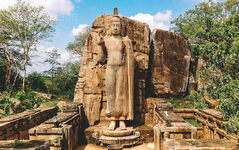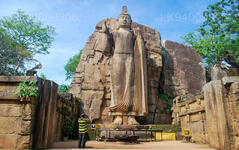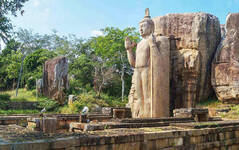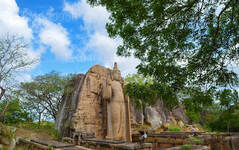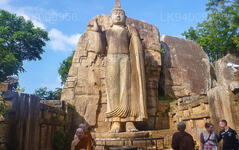
Città di Anuradhapura
Anuradhapura appartiene alla Provincia Centro-Settentrionale dello Sri Lanka. Anuradhapura è una delle antiche capitali dello Sri Lanka, famosa per le sue rovine ben conservate dell'antica civiltà lankese. La città, oggi Patrimonio dell'Umanità UNESCO, si trova 205 km a nord dell'attuale capitale Colombo, in Sri Lanka.
Aukana Buddha Statue
Aukana Buddha statue is located 30km northwest of Dambulla close to the ancient Kala Weva man-made rainwater reservoir. It can be reached from Kekirawa on Dambulla-Anuradhapura road.
The tallest ancient Buddha statue of Sri Lanka
Aukana Buddha Statue in Sri Lanka that rise to a height of 11.36 meters, is the tallest ancient Buddha statue in Sri Lanka.
The posture of the statue
Aukana Buddha Statue in Asisa Mudra or the “posture of blessing” is carved out of a rock boulder. The statue is carved in the round connected to the back to the rock boulder. The delicate and skillful carving of the Buddha’s robe humanizes and chastely reveals the underlying form of his body, while the face’s impassive expression projects an aura of spiritual supremacy.
It is said that the degree of alignment of the statue is such that raindrop on the nose would drop straight down to a small depression carved between the toes. Aukana Buddha Statue is a masterpiece of a colossal Buddha Statue by an unknown sculptor: the serene expression of the statue, the gracefully carved robe with neat pleats brings in delicateness that could hardly be molded into a rock. The impassive expression of the face reflects the supreme spirituality.
The sculpture in proportion
Aukana Buddha Statue is carved alone in the proportion of nine faces: the body height is nine times the length of the face. The proportion of nine faces is the iconometry followed by the sculptors in the eighth century AC of Sri Lanka.
Sirasapata
Sirasapata is the symbol placed on the top of the Buddha images in Sri Lanka. The sirasapata found on the head of Aukana Buddha statue is believed to be a modern addition in the year 1870. The discovery of a fragment of a sirasapata in the premises of the site suggests there had been a sirasapata on the head of the statue nearly a century before 1870. This turn of events has lead to the study of whether sirasapata had existed from the very beginning in the 8th century AD. According to Buddhist literature, sirasapata have existed in all four previous Buddhas. The introduction and existence of sirasapata have been consistent in Sri Lanka since the second half of the fifth century A.D. with several exceptions. Hence it is believed Aukana Buddha Statue too was adorned with a sirasapata.
Drapery
Drapery, the art of draping the statues in folds is prominent in the Aukana Buddha statue. The robe in single groves is draped over the left shoulder to fall over the left shoulder up to the ankle. The right shoulder is left bare.
Pedestal
Aukana Buddha statue stands on a pedestal, the front of which is carved off a slab of stone in the form of a double petal lotus flower called Padmasana meaning the Lotus seat.
School of Art
Iconography, the study of characteristics of statues, the Avukana Buddha, particularly the sirasapata, pedestal, and the style shows Aukana Buddha statue belongs to Anuradhapura school of art.
Dating Aukana Statue
The difference in opinion of the experts of the dating of Aukana Buddha statues was finally resolved following the discovery in the year 1952, of an inscription on a granite slab built onto the northern wall of the shrine. The statue was sculpted in the second half of the 8th century AD when Mahayana Buddhism threatened to take root in Sri Lanka.
Informazioni sul distretto di Anuradhapura
Anuradhapura appartiene alla Provincia Centro-Settentrionale dello Sri Lanka. Anuradhapura è una delle antiche capitali dello Sri Lanka, famosa per le sue rovine ben conservate dell'antica civiltà cingalese. La città, ora Patrimonio dell'Umanità UNESCO, si trova 205 km a nord dell'attuale capitale Colombo, in Sri Lanka. Nella città sacra di Anuradhapura e nelle sue vicinanze si trovano numerose rovine. Le rovine consistono in tre classi di edifici: dagoba, edifici monastici e pokuna (stagni). La città possedeva alcuni dei sistemi di irrigazione più complessi del mondo antico; situata nella zona arida del paese, l'amministrazione costruì numerose cisterne per irrigare i terreni. La maggior parte dei civili è cingalese, mentre nel distretto vivono anche tamil e mori dello Sri Lanka.
Informazioni sulla provincia centro-settentrionale
La Provincia Centro-Settentrionale, la più grande del paese, copre il 16% della superficie totale del paese. La Provincia Centro-Settentrionale è composta da due distretti chiamati Polonnaruwa e Anuradhapure. Anuradhapura è il distretto più grande dello Sri Lanka. La sua superficie è di 7.128 km². La Provincia Centro-Settentrionale ha numerose potenzialità per gli investitori che desiderano avviare le proprie attività, in particolare nei settori dell'agricoltura, dell'industria agroalimentare e dell'allevamento. Oltre il 65% della popolazione della Provincia Centro-Settentrionale dipende dall'agricoltura di base e dall'industria agroalimentare. La Provincia Centro-Settentrionale è anche chiamata "Wew Bendi Rajje" perché nella provincia si trovano più di 3.000 serbatoi di medie e grandi dimensioni. Sri Maha Bodiya, Ruwanweli Seya, Thuparama Dageba, il monastero di Abayagiri, Polonnaruwa Rankot Wehera e Lankathilake sono luoghi di interesse.

